When looking for antique sleigh bells, it is very easy to be overwhelmed by your initial excitement of finding a "real" antique, which is often heightened by the seller's or auctioneer's hype. To avoid being burned, you need to be able to quickly pick out key details that separate true antiques from overpriced reproductions. My goal in these case studies is to help you develop this skill.
First, some definitions:
When I use the term "antique" on this website, I am specifically talking about bells made during the "horse and buggy times". Antique North American sleigh bells date from the 1700s through the 1920s.
When I use the terms "new" or "modern" or "vintage" or "reproduction", I am referring to sleigh bells made after the era of horse transportation -- from the 1930s through today.
After reading this article, see also Fakes I: Old Bells that Aren't, Fakes II: Old Straps that Aren't, Dating Bells, and Bell Designs for more information. You can also compare the antique and new bells we have for sale.
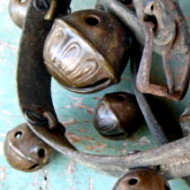

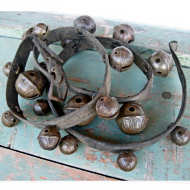
Left: Overall view of the strap looks promising -- the buckle is intact on the strap and the leather is older. The bells have a fairly consistent color that appears natural in this photo.
Middle: A closup view of the strap shows an odd line of stitching that has no purpose on a bell strap, an indicator of a recycled strap. One bell has an odd patch of rusty color (far right).
Right: The larger bell to the left of the buckle does not have a larger, round opening at the end of the throat (slit) as an antique petal bell should. Other bells on the strap also appear to have a constant width throat.
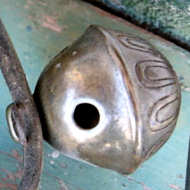
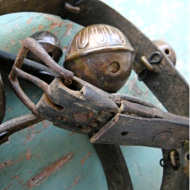
Left: The buckle and the leather folded over the buckle look genuinely old. The cut on the end of the main strap is fresh, however, and the buckle has been carelessly fastened onto the strap with a copper rivet. These details indicate a recent, sloppy "repair".
Middle: The bell pin is irregularly shaped, is made of lighter weight wire, and has no rust. It does not look especially old.
Right: A closer look at this bell shows the coarse ornamentation typical of a modern petal bell.
Case Study 1 conclusion: This piece is a set of new bells installed on a recycled leather strap.
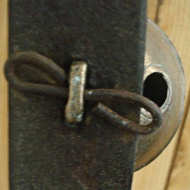
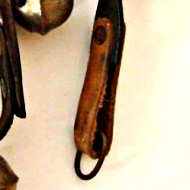

Left: This strap is in poor shape -- it is missing its buckle and tongue ends and has at least one repair in the center of the strap. The bells have an even, natural golden-brown color.
Middle: A ring has been crudely fastened onto one end of the strap with a piece of lighter-colored leather and a copper rivet. This repair may indicate the strap is recycled leather, but the picture is inconclusive.
Right: The bell pin is well formed. The wire is thicker than the bell pin in Case Study 1. The wire thickness, symmetrical shape, and light coating of rust are consistent with an older bell pin.
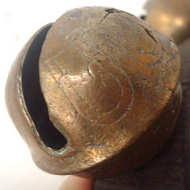
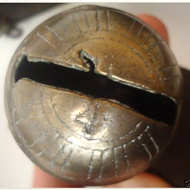
Left: The #4 bell has a casting defect on the top. Its petal ornamentation is crisp, delicate, and well formed. Both are typical of an antique bell.
Right: A second bell shows stress cracks that are consistent with heavy use. Again, the ornamentation is typical of an antique petal bell.
Both photos: These bells clearly have larger rounded openings at the ends of their throats -- a key characteristic of antique petal bells.
Case Study 2 conclusion: This piece is a set of antique bells on an older strap. It is not clear whether the strap is a badly damaged original or a piece of recycled leather.
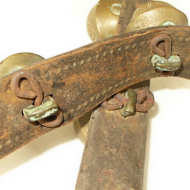
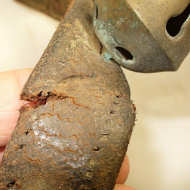
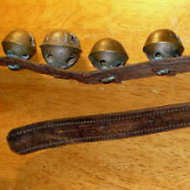
This leather strap is definitely old and fragile. It does not look like an original bell strap -- the lines of old stitching that even extend through the billet (tongue) area of the strap (left photo) are a hint that the strap was made from recycled leather.
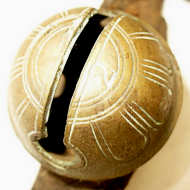
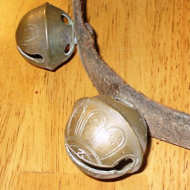
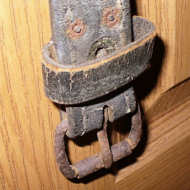
The buckle also shows age and is consistent with an early 1900s bell or harness strap. The bells have large circular openings at the ends of their throats (slits) and have the delicate designs of antique bells. The white residue in the design on the right-hand bell is probably old brass polish that was not completely removed.
Case Study 3 conclusion: The bells are antiques on a recycled leather strap.
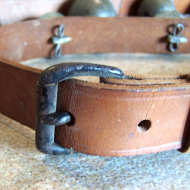
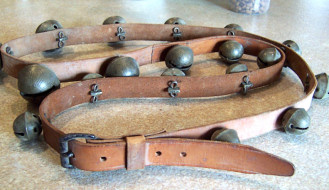
The bell strap is light colored leather with light surface cracking and appearance of some age. It was made by someone who was a competent harness maker or leather worker, possibly in the mid 1900s. The entire set of bells has a consistent brownish color.
The black "japanned" steel buckle shows some chips, but not a lot of wear. Black lacquered steel buckles like this were commonly used by harness makers from the late 1800s through the mid 1900s. In the mid 1900s, solid brass and chrome- or nickel-plated brass hardware became available. Stainless steel buckles are newer -- they date to the late 1900s through today.
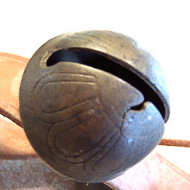
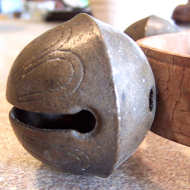
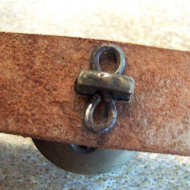
The bell pin is nicely formed from thick, sturdy wire. It does not show much rust or apparent age, but it was obviously hand made by someone who knew how to make useful bell pins. The bells have rounded ends on their throats and delicate design lines. Some bells show damage consistent with use and age.
Case Study 4 conclusion: The piece is a set of antique bells on a vintage leather strap.
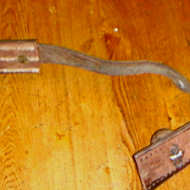
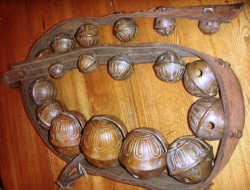
The bells look rusty colored. Some pairs of adjacent bells show quite a variation in color. The leather shows old stitch lines that have no useful purpose. The ends of the strap have been recently cut cleanly across.
A narrow billet (tongue) has been fastened to one end with a single copper rivet. For horse use, stitching or two rivets would be required for strength and durability.
A "dee" has been riveted onto the loose end of the billet so the strap can be hung on a hook. The bell pin is well formed, but is not made from heavy wire. In horse use, this pin would deform and break relatively quickly from the stress of supporting a heavy bell.
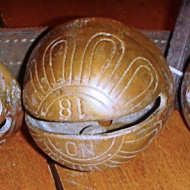
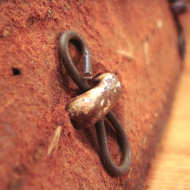
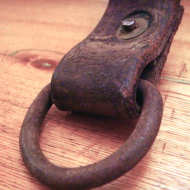
In the closeup photo (far right), the bell does not have larger rounded openings at the ends of the throat, the "No 18" marking is plain block lettering, and the suspicious rusty color is clear.
Case Study 5 conclusion: This piece is a set of modern bells with an artificial patina installed on a recycled leather strap.
Copyright © 2002-2025 - All rights reserved by Classic Bells Ltd.
Template by OS-templates.com